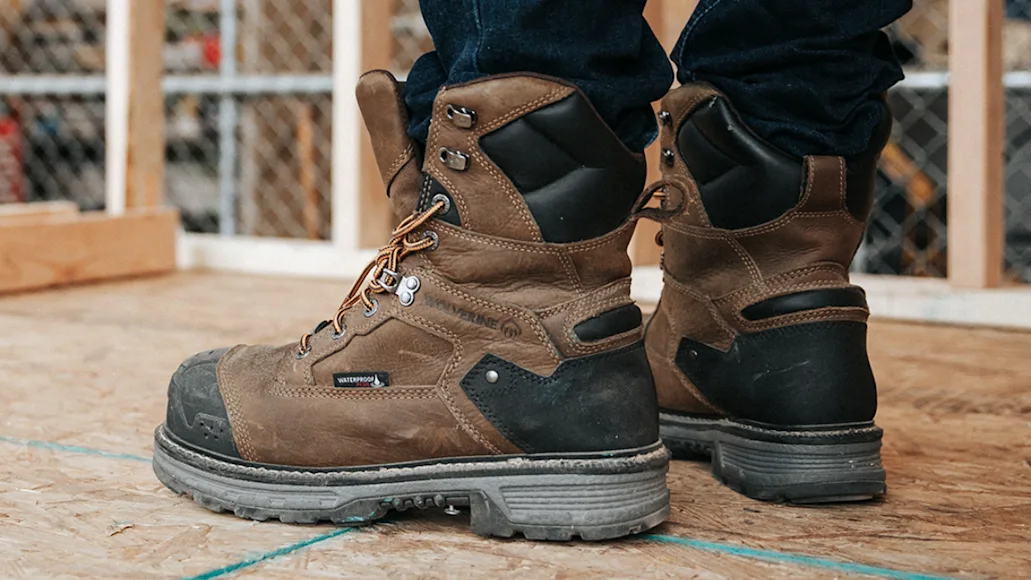_We may earn revenue from the products available on this page and participate in affiliate programs. Learn more ›
_
Best Overall
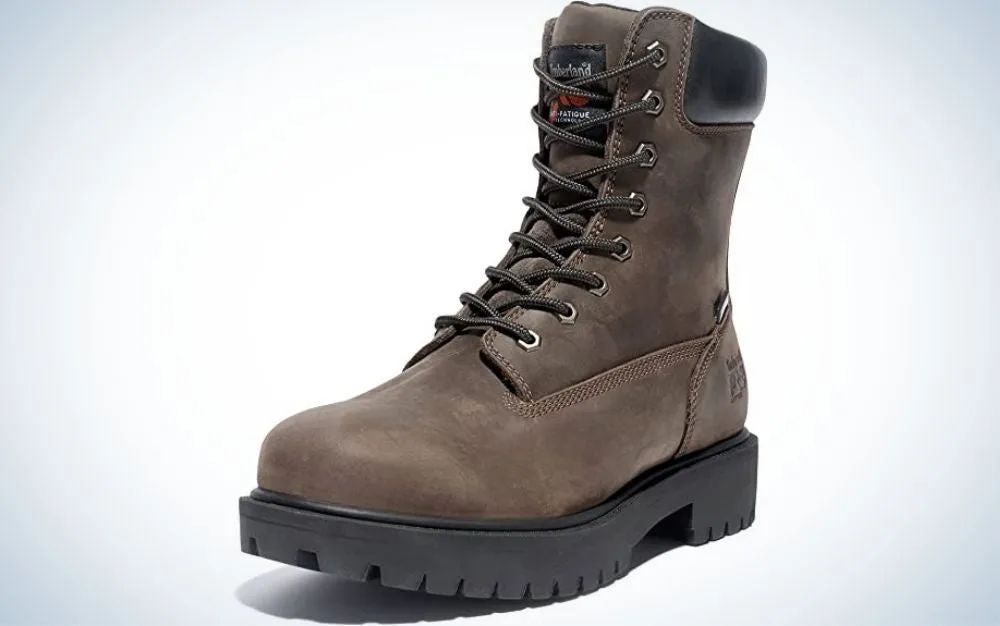
Timberland PRO Direct Attach Work Boot
LEARN MORE
Summary
Timberland’s PRO winter work boot is an outstanding cold-weather option that is tough, supportive, and keeps feet dry and warm.
Best Value

Kamik Icebreaker Insulated Winter Boots
LEARN MORE
Summary
Kamik’s Wellington-style tall winter work boot offers great protection against the elements, is easy to look after, and comes at an affordable price.
Best Women’s
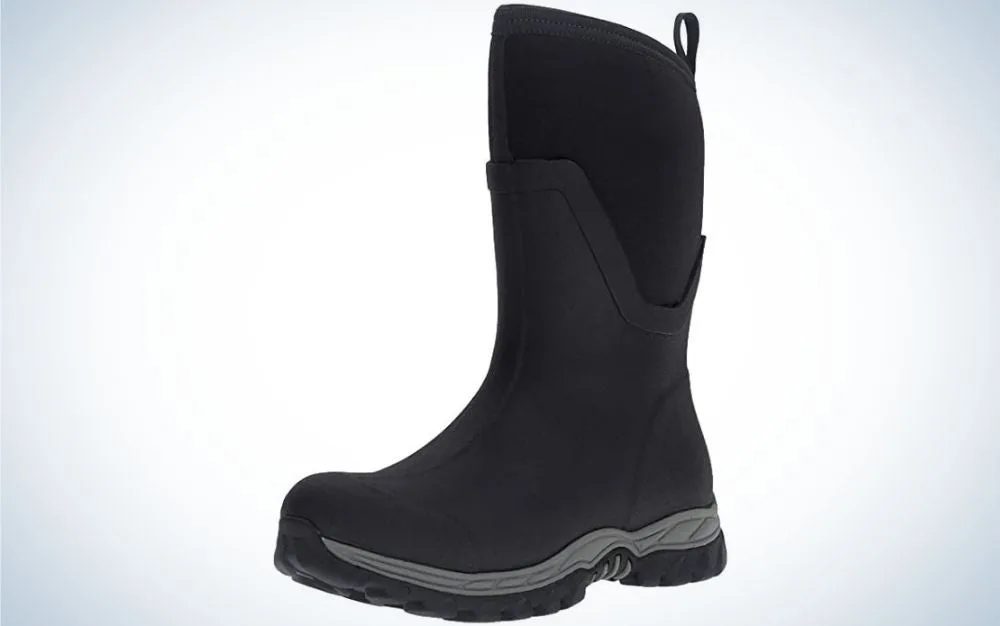
Muck Boots Arctic Ice Snow Boot
LEARN MORE
Summary
Muck Boots Arctic Ice is specifically designed for the female foot shape, offers excellent warmth and comfort, and comes in a range of funky colors.
Everyone who has ever had cold feet in winter work boots knows the nagging discomfort they bring. In any situation it’s unpleasant. At work it can actually be dangerous. Having cold feet makes it difficult to focus, and can result in accidents. Frostbite can start to be a hazard at 5 degrees F, and while a tingling or burning sensation is often an early sign, it can creep up without warning. In extreme conditions there’s a real risk of losing toes.
OK, so that all sounds pretty frightening—but the solution is easy. All you need is a good pair of insulated winter work boots. There is plenty of choice, but that can make it hard to identify which type is right for the work you do, and the conditions you face. Good comfortable work boots
aren’t cheap, so you want to be sure you’re getting great value. Below, we’ve reviewed the best winter work boots for men and women based on construction, materials, technology, and comfort.
Best Overall: Timberland PRO Direct Attach Work Boot
Best Budget: Kamik Icebreaker Insulated Winter Boots
Best Women’s: Muck Boots Arctic Ice Snow Boot
Best Pull On: Wolverine Durashock-M Pull-On Work Boot
Best Steel Toe: Rocky Steel Toe Whole 8 Work Boot
Best Composite Toe: Carhartt Waterproof Insulated PAC Boot
How I Picked The Best Winter Work Boots
I’ve owned various brands of winter work boots over the years. My current pair are in need of replacement, so I was interested to research the top brands, and the best of their ranges. I also took into account feedback from owners who have used their winter footwear in a variety of different conditions, and the views of independent experts.
While the physical considerations outlined above were the main criteria, we also looked at the following:
Choice: When looking for the best winter work boots, much depends on your occupation. The choice of styles is extensive, and in making my picks I tried to find prime examples of each type, thus offering something for the widest possible range of workers.
Wearability: Wearability is difficult to define. In part, it’s comfort and warmth, of course. But it’s also things like having a wide opening so the boots are easy to put on. Speed closures so they can be laced up quickly. Or a drawstring top that will help keep out drafts. When making my selections, I didn’t just consider cold weather performance, but also all the little things that impact day-to-day use.
Brand and Price: It isn’t difficult to find cheap winter work boots, but they seldom live up to expectations. No matter how low the cost, that makes them poor value. I chose brands that have a long-standing reputation for quality. While prices may be a little higher, their durability makes them a much better long-term investment.
The Best Winter Work Boots: Reviews & Recommendations
Best Overall: Timberland PRO Direct Attach Work Boot
Best Overall

Timberland PRO Direct Attach Work Boot Timberland PRO
Specs
Material: Full-grain leather
Sizes: 7 to 15 (including wides)
Insulation: 400g Thermolite
Pros
Seam-sealed construction
Oil-resistant, high-traction sole
Comfortable, antimicrobial footbed
Cons
No safety toe
Slightly narrow opening
Timberland PRO has long been recognized as one of the top work-boot brands. The Direct Attach is one of their winter models, taking its name from the seal used to bond the upper to the sole. With no visible stitching between the two components, there’s nowhere for water to get in. Variations of this idea are used on many of the best winter work boots. On the Timberland PRO Direct Attach, it is backed up with a full-length interior membrane so the whole boot is completely waterproof.
The upper is made from tough, full-grain leather. The sole is composite rubber with deep lugs that are well spaced to prevent clogging. It is oil-resistant, and non-marking. On the inside, 400g of Thermolite insulation is used. This is made by the Lycra company, and is similar to Thinsulate but claims to be lighter. Unlike natural fibers it maintains warmth even when wet. An anti-fatigue system combines an open cell polyurethane footbed for added comfort with nylon shock diffusion plates that spread the impact across the sole. This model has a soft toe, which helps keep weight down. A steel-toe version is available for those who need additional protection.
The 8-inch height offers good splash and abrasion protection, and the padded top provides a snug fit. However, the 10.5-inch opening is a little narrow, and normal lace holes run all the way up rather than speed hooks. As a result, the Timberland PRO Direct Attach takes longer to put on than some other winter work boots.
Best Budget: Kamik Icebreaker Insulated Winter Boots
Best Budget:

Kamik Icebreaker Insulated Winter Boots
Specs
Material: Lightweight composite rubber
Sizes: 7 to 15
Insulation: 8mm Zylex
Pros
Removable insulation for all-year use
100 percent recyclable materials
Excellent value
Cons
Possible quality control issues
No half sizes or wides
Kamik is a brand that isn’t particularly well known in the U.S., but they’ve been making warm winter work boots in Canada for more than 120 years. They have a particular focus on sustainable materials, and every part of the Kamik Icebreaker boot is recyclable.
The boot upper is made from composite rubber. The sole is a Kamik development called RubberHe which is light, and offers superior traction on ice, snow, and slush. This is helped by a unique lug design. The two pieces are “welded” together to form a continuous waterproof exterior.
Inside the boot is the Zylex insulation in the form of a removable liner, so the Icebreaker boots can also be used during the summer. Zylex is another Kamik product, this one made from 97 percent recycled materials. It claims to cope with temperatures down to -40 degrees F.
Knee-high boots can be awkward to get into, but apparently the trick with this one is to take out the insulating liner, put it on like a sock, then put the boot on. Thanks to the low friction material feet slide in easily.
The Kamik Icebreaker comes at a very attractive price, particularly for those who want a Wellington-style waterproof boot. We have occasionally found complaints of boots splitting or leaking, though these seem to be isolated incidents rather than a common fault.
Best Women’s: Muck Boots Arctic Ice Snow Boot
Best Women’s

Muck Boots Arctic Ice Snow Boot Muck Boot
Specs
Material: Neoprene
Sizes: 5 to 11
Insulation: Fleece
Pros
Flexibility allows good movement
Withstands cold to -40°F
5 colors
Cons
No half sizes
Premium price
Muck Boots started in 1999, and quickly built a reputation for durable, 100-percent waterproof footwear. The Arctic Ice Snow Boot has a neoprene upper. This synthetic rubber material is tough but very flexible. In spite of a shaft height that offers good protection, the boot allows plenty of movement for work or leisure activities. Most owners find them easy to put on, with a snug fit helps reduce chafing, though a few have said they can be tight in the calf.
The composite rubber sole comes from highly-regarded specialist Italian manufacturer Vibram. The material is hard-wearing but has excellent grip that is unaffected by cold, so it works well in snow and ice. The lug pattern also helps force water from under the foot.
The liner is fleece, a natural fiber known for its heat retention. According to Muck Boots, it is “comfort rated” from -40 F to 40 degrees F. There is also an insole to add cushioning.
The Muck Boots Arctic Ice Snow Boot is very well-made, and offers good versatility. It makes an excellent choice as a general-purpose women’s winter work boot. However, it does carry a premium price tag. There are no half sizes, and no safety toe.
Best Pull On: Wolverine Durashock-M Pull-On Work Boot
Best Pull On
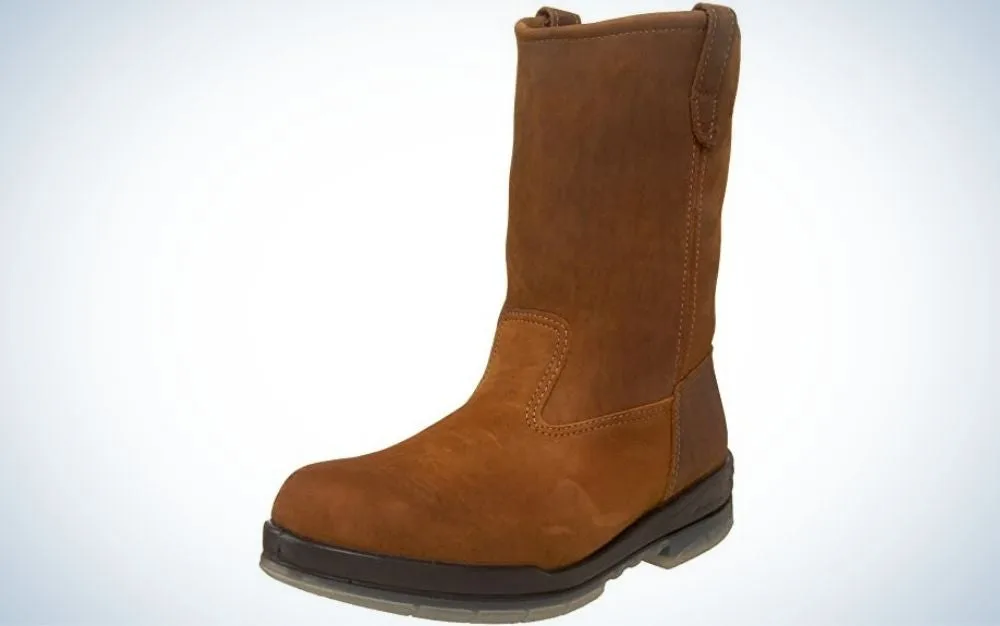
Wolverine Durashock-M Pull-On Work Boot Wolverine
Specs
Material: Full-grain leather
Sizes: 7 to 14
Insulation: 200g Thinsulate
Pros
Shock absorbing compression pads
Supportive fiberglass shank
Steel safety toe (cost option)
Cons
Modest insulation
No wides
Wolverine’s reputation for high quality comes from well over 100 years of footwear experience. Their winter work boot combines traditional craftsmanship with modern materials technology in a western-style pull-on boot
that has the toughness necessary for the jobsite, but looks just as good off it.
The upper is full-grain leather that has been oil tanned to make it more supple. The break-in period is minimal, which is unusual for a full leather boot. The treatment also adds water resistance. The upper is bonded to a slip-resistant composite rubber sole. Also incorporated is Wolverine’s Durashock system. Compression pads are molded into the sole for additional shock absorption. There is also a fiberglass shank that runs through the midfoot area providing support for the foot, and helping reduce fatigue.
Inside, there is a waterproof, moisture-wicking membrane, plus 200g Thinsulate. While this isn’t as thick as some competitors, it is claimed to keep feet warm down to -20 degrees F, so the Wolverine winter work boot is good for all but the harshest conditions. A double density footbed provides good cushioning, and helps stop foot movement that can cause blisters. A steel safety toe is an option at extra cost. Unfortunately, wides are not available.
Best Steel Toe: Rocky Steel Toe Whole 8 Work Boot
Best Steel Toe
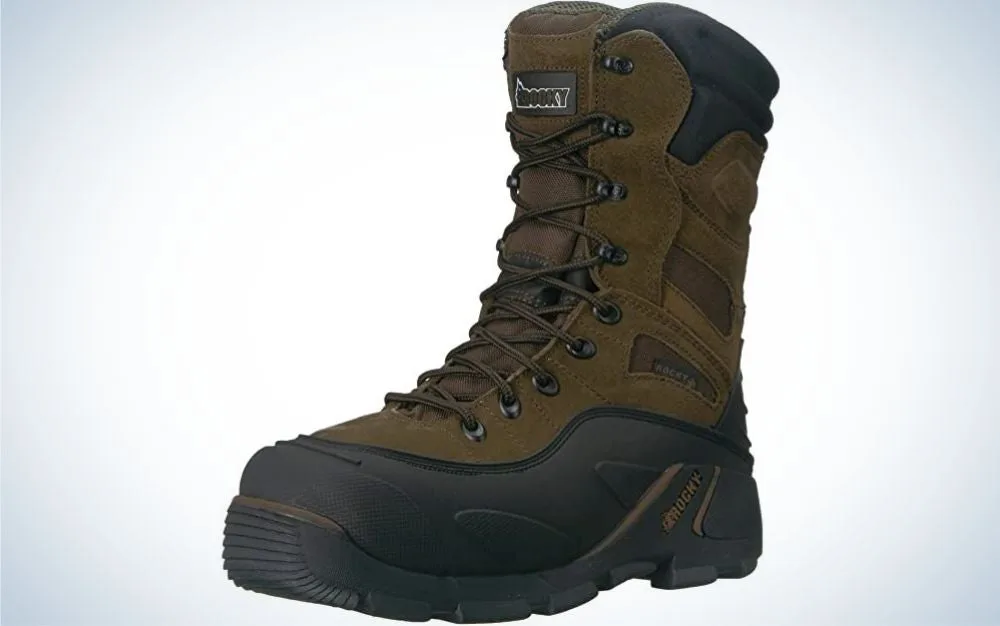
Rocky Steel Toe Whole 8 Work Boot Rocky
Specs
Material: Split suede and nylon
Sizes: 7 to 14
Insulation: 1200g Thinsulate Ultra
Pros
Can withstand severe temperatures
ASTM-rated toe
Good value
Cons
A little heavy
Occasional seam faults
Rocky are perhaps not the best-known winter work boot brands, yet they are no newcomers having made outdoor and military footwear for 90 years.
The Rocky Whole 8 steel toe winter work boot uses an interesting combination of materials. The upper is mostly split suede, which as the name suggests, is made by splitting the hide in two to maximize value. The top layer is often used for casual footwear, while the coarser underside is often used for suede.
While not as tough as full-grain leather, split suede is still hard-wearing. Rocky adds composite rubber to the heavy abrasion areas around the toe and heel, both for increased durability and extra foot support. At the top of the shaft, a strong 900 denier nylon collar seals in the warmth.
The interior is the main reason this model gets our best steel-toed boots
recommendation. It has Rocky’s own waterproof membrane, and 1200g of Thinsulate Ultra, which is thinner than standard Thinsulate in order to minimize bulk. A polyurethane footbed cushions the foot, and the ASTM-rated steel safety toe provides high impact and compression protection. The sole has multi-directional lugs for high traction.
The Rocky Whole 8 winter work boot offers a class-leading level of insulation, and is competitively priced. Although we have read reports of seam failures, these appear to be rare.
Best Composite Toe: Carhartt Waterproof Insulated PAC Boot
Best Composite Toe
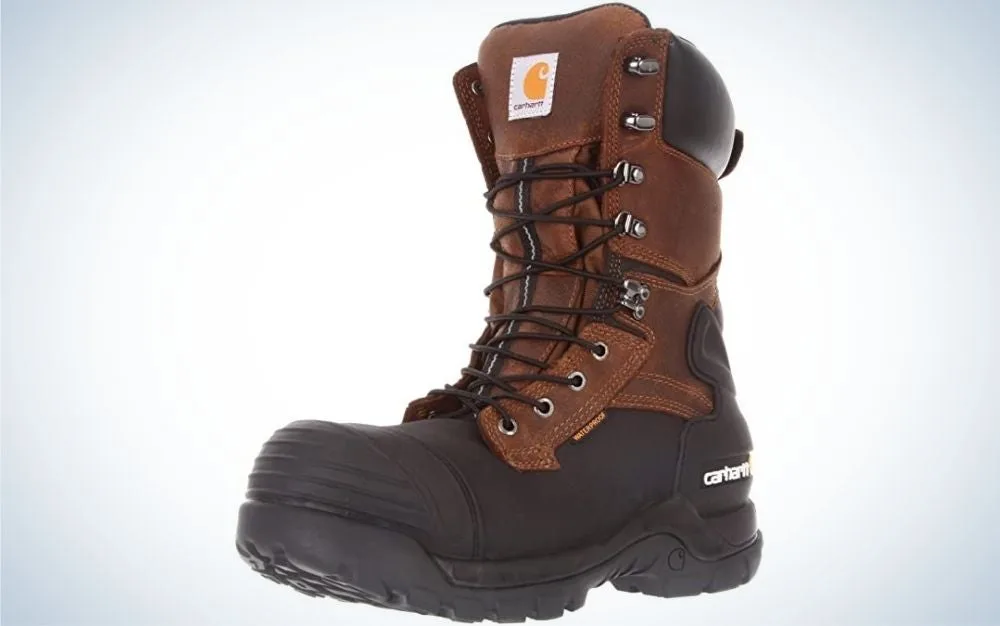
Carhartt Waterproof Insulated PAC Boot Carhartt
Specs
Material: Full-grain leather
Sizes: 8 to 15
Insulation: 1000g LiteFire
Pros
Made for the coldest conditions
Impact and secondary electrical protection
Reduced weight
Cons
Some time to break in
No wide sizes
Carhartt is another brand with a long history of making top quality work boots. This model has the expected full-grain leather upper for toughness, with a padded cuff and extended tongue to keep out dirt and grit, as well as the worst of the weather.
Inside, there is 1000g of the company’s own LiteFire insulation that provides warmth in the worst of conditions. The boot benefits from Carhartt’s own Storm Defender waterproof membrane which is also breathable to reduce overheating and sweat. A removable EVA foam insole cushions the foot, and a thermoplastic polyurethane arch adds another layer of comfort and support.
The composite (non-metallic) safety toe has two ASTM
ratings. The first is for resistance to impact and compression. The second is as secondary electrical protection of up to 18,000 volts (in dry conditions).
The deep-lugged rubber sole ensures safe footing on slippery surfaces. The rubber extends over the toe for additional abrasion resistance, and around the heel to help prevent twisting injuries.
What to Consider When Choosing Winter Work Boots
It makes sense that the best winter work boots, like the best winter hiking boots
, need effective insulation, but that’s just one of a number of features to look for. Here’s what you need to know.
Insulation
Natural fibers have long been used for winter boot insulation. Goose down was used in casual footwear for generations, though it lacks the durability necessary for work boots. Shearling, which is sheep hide that is tanned with the fleece left on, is very effective. Quality does vary, but good shearling is so warm and comfortable that socks may be unnecessary.
The drawbacks with shearling are bulk, weight, and, to some extent, durability. A thicker layer is required when compared to modern synthetics, and the material can wear more easily. It also requires more care, without which the wool fibers can eventually become matted.
The most popular synthetic alternative is Thinsulate made by 3M. This retains heat by trapping air in tiny fibers or cavities. It is extremely effective, thin, and hard wearing. Several boot brands produce their own versions.
Synthetic insulation usually has a rating that gives the weight of insulation per square meter. A 400g synthetic insulation, for example, is equal to roughly 1.3 ounces per square foot; 800g has twice the density. While these figures don’t really mean much in practical terms, they are useful for comparison. Many manufacturers also give actual temperature ranges.
Protection
There are two types of protection to consider with the best winter work boots: weather protection and impact protection. All of the winter work boots that we recommend are waterproof. Wellington-style models made of composite rubber are naturally waterproof, whereas leather versions need a liner or membrane. This is often GoreTex, though there are several others. It’s important to understand that GoreTex and similar products are effective waterproof membranes, but not insulators.
For impact protection a safety toe is added. These can be steel or composite, which can be a mix of carbon fiber, fiberglass, or kevlar. Steel is less expensive, composites are lighter, and also less affected by cold. For work purposes it’s important to look for the ASTM F2413 standard that guarantees a certain level of protection from impact or crushing.
Traction
Secure footing is always important, especially in bad weather. The soles on winter work boots are often called rubber, but are in fact composites that include rubber. This makes them more durable, and gives better grip particularly in cold and icy conditions. Polyurethane soles have similar properties. Work boot soles often have deep lugs (tread) that have a similar design to vehicle tires so that they actively displace liquid as you walk.
Comfort
Winter work boots that are going to be worn all day need to be comfortable as well as warm. A snug fit is a big part of this, so having a good range of sizes—including half sizes and wides—can be beneficial.
While some insoles are quite basic, others offer better padding, or memory foam that molds itself to the shape of your foot. Footbeds may be shock-absorbing. Heel arches sometimes have a steel or nylon shank that adds support, and protection. Heel and ankle areas may also be reinforced to reduce the likelihood of twisting.
Adding strength to leather boots usually increases the initial stiffness. As a result, some models take a week or so to break in.
FAQs
Q: What makes winter work boots better than regular boots?
The main thing that makes winter work boots better than regular boots is insulation. As discussed above, keeping your feet warm not only improves comfort but also energy levels, and personal safety.
Q: How much do winter work boots cost?
How much winter work boots cost depends on the materials used, and the construction quality. We advise avoiding cheap winter work boots because performance usually disappoints. We think it’s unlikely you’ll find acceptable quality under $50, and some of the best winter work boots are over $200.
Q: What brands of winter boots are the warmest?
Among the warmest brands of winter work boots are well-known names like Ariat, Carhartt, Danner, Red Wing, Thorogood, Timberland, Twisted X, and Wolverine. It’s important to check the level of insulation provided, and you’ll find more detail on this in our article above.
Q: What are the recommended heights for the best work boots for winter?
The recommended heights for the best work boots for winter will depend on the activity. We wouldn’t recommend anything under 6 inches. Eight to 10 inches are probably most common. Knee-high winter work boots are also popular for the overall protection they provide in the wet.
Q: What types of safety toes should I use in cold weathers?
The type of safety toes you should use in cold weather will depend on how extreme the temperatures get. Steel safety toes are tough, and often more affordable, but once they get cold there is a danger they can radiate that to the rest of the foot. Composite safety toes are much less prone to this. However, the thickness of insulation, and where it is in terms of the toe also has an impact. It’s important to consider the construction as a whole.
Q: How do I take care of the boots?
You should take care of the boots as recommended by the manufacturer. Rubber boots need little or no maintenance. Leather boot care
usually involves periodic treatment with a good oil or wax. Instructions should be provided, and following them will maximize the life of your winter work boots.
Best Winter Work Boots: Final Thoughts
Best Overall: Timberland PRO Direct Attach Work Boot
Best Budget: Kamik Icebreaker Insulated Winter Boots
Best Women’s: Muck Boots Arctic Ice Snow Boot
Best Pull On: Wolverine Durashock-M Pull-On Work Boot
Best Steel Toe: Rocky Steel Toe Whole 8 Work Boot
Best Composite Toe: Carhartt Waterproof Insulated PAC Boot
The Timberland PRO Direct Attach
is an outstanding all-round winter work boot. It is made with quality materials, and great attention to detail. Those who consistently work in severe weather might want more insulation, but the 400g Thinsulate is good down to around -40°F.
While we didn’t find any especially cheap winter work boots that we felt we could recommend, the Kamik Icebreaker
is certainly affordable. The removable Zylex liner means it’s not just a comfortable and effective winter work boot but can also be used when the temperature rises.
Why Trust Us
For more than 125 years, Field & Stream has been providing readers with honest and authentic coverage of outdoor gear. Our writers and editors eat, sleep, and breathe the outdoors, and that passion comes through in our product reviews. You can count on F&S to keep you up to date on the best new gear. And when we write about a product—whether it’s a bass lure or a backpack—we cover the good and the bad, so you know exactly what to expect before you decide to make a purchase.

